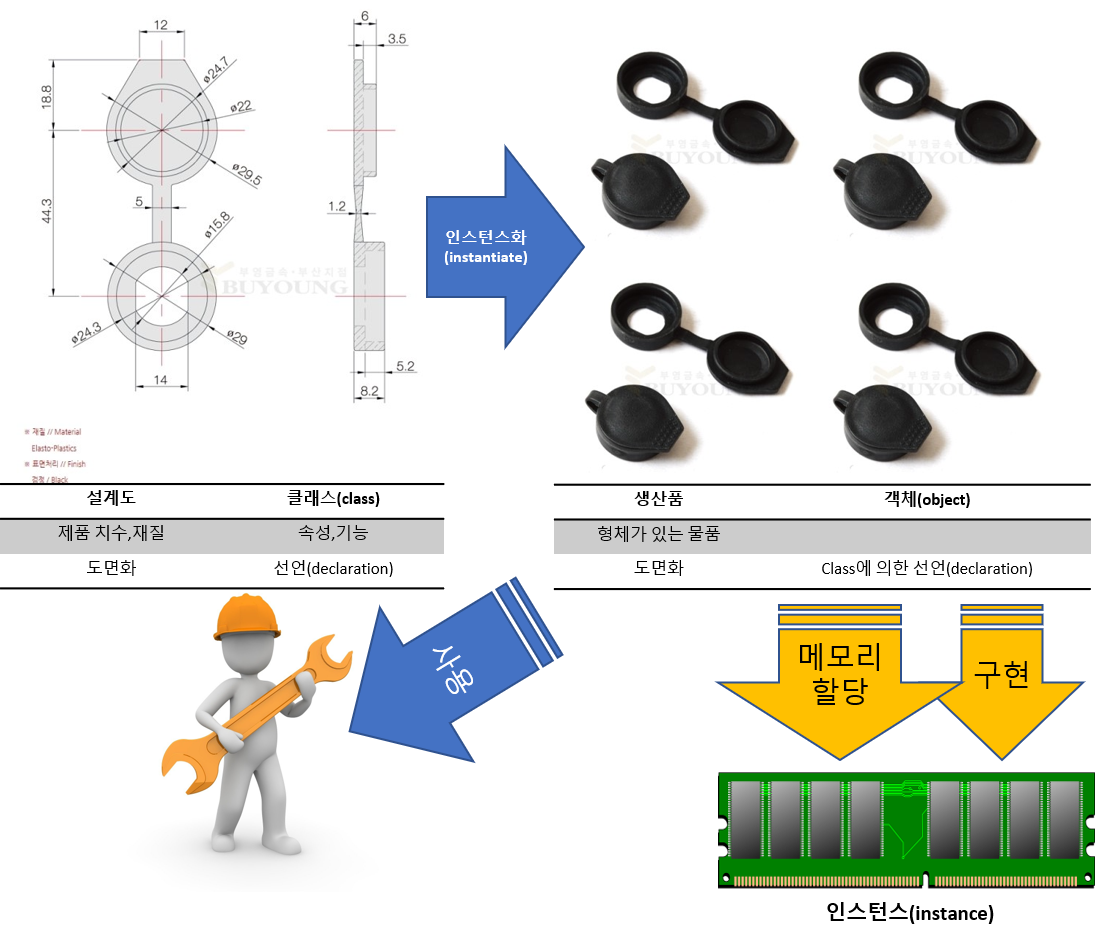1. 클래스란?
- 자바 프로그램 구성의 기본 단위이다
- 객체(object)를 생성하기 위하여 정의한 설계도(blueprint) 또는 틀(frame)이다
- 객체(object)는 클래스(class)에 의해 정의되고, 클래스에 의해 설계된 내용을 생성한 결과물이다
- 자바는 객체지향 언어이기 때문에 모든 코드를 클래스 내에서 작성한다
- 객체의 구조를 클래스 내에서 코드로 정의하면 이후에 동일한 구조의 클래스는 쉽게 생성할 수 있다
- 객체의 상태는 필드(데이터)로, 행위는 메소드로 구현된다
- 객체는 특정 클래스의 인스턴스이다
- 클래스는 자체로 타입으로 사용할 수 있으며 연관된 기능들을 묶을 수 있다
※ 인스턴스(instance)
- 클래스를 통해 생성된 객체를 말한다
- 클래스로부터 객체를 만드는 과정을 '인스턴스화(instantiate)라고 한다
- 객체와 인스턴스는 비슷한 맥락의 의미를 가지지만 객체가 메모리에 할당되어 구현될 때를 인스턴스로 볼 수 있다

2. 클래스 구성
1) 필드(field)
- 클래스의 속성(state)을 나타내는 변수
- 모델명, 컬러, 바퀴의 수 등등...
2) 메서드(method)
- 클래스의 기능(behavior)을 나타내는 함수
- 시동걸기, 가속하기, 정지하기 등등...
3) 생성자(constructor)
- 클래스의 객체를 생성하는 역할
4) 이너 클래스(inner class)
- 클래스 내부의 클래스를 의미
※ 필드, 메서드, 이너클래스 3요소를 클래스의 멤버(member)라고 부른다

※ 참조 링크
▶ 해시넷 클래스 : http://wiki.hash.kr/index.php/%ED%81%B4%EB%9E%98%EC%8A%A4
클래스 - 해시넷
클래스(class)란 객체 지향 프로그래밍(OOP)에서 새로운 객체(object)를 만들기 위한 템플릿을 말한다. 클래스를 사용하여 인스턴스(instance)를 생성함으로써 객체를 만들 수 있다. 파일 확장자는 .class
wiki.hash.kr
▶ 위키피아 클래스 : https://en.wikipedia.org/wiki/Class_(computer_programming)
Class (computer programming) - Wikipedia
From Wikipedia, the free encyclopedia Jump to navigation Jump to search Definition in programming that specifies how an object works In object-oriented programming, a class is an extensible program-code-template for creating objects, providing initial valu
en.wikipedia.org
3. 내부 클래스(Inner Class)
- 클래스 내에 선언된 클래스이다
- 외부 클래스와 내부 클래스가 서로 연관되어 있을 때 사용한다
- 내부 클래스를 사용하면 외부 클래스의 멤버들에 쉽게 접근 할 수 있고, 코드의 복잡성을 줄일 수 있다
- 외부적으로 불필요한 데이터를 감출 수 있어 캡슐화(encapsulation)를 달성하는 데 유용하다
- 기본적으로 내부 클래스는 외부 클래스 내에 선언된다는 점을 제외하면 일반 클래스와 차이점이 없다
- 외부 클래스와 내부 클래스가 서로 연관되어 있을 때 사용의 편의성을 고려하여 만들어진 문법 요소이다
class Outer { // 외부 클래스
class Inner {
// 인스턴스 내부 클래스
}
static class StaticInner {
// 정적 내부 클래스
}
void run() {
class LocalInner {
// 지역 내부 클래스
}
}
}- 내부 클래스의 종류는 세가지로 구분한다
- 인스턴스 내부 클래스
- 정적 내부 클래스
- 지역 내부 클래스 - 세 가지 내부 클래스는 변수가 선언 위치에 따라 인스턴스 변수, 클래스 변수, 그리고 지역 변수로 구분되는 것과 유사하게 그 위치를 중심으로 구분될 수 있다
- 각각의 유효범위(scope)와 특성이 변수의 구분과 매우 유사하다
- 내부클래스 종류
| 종 류 | 선언 위치 | 사용 가능한 변수 |
| 인스턴스 내부 클래스 (instance inner class) |
외부 클래스의 멤버변수 선언위치에 선언(멤버 내부 클래스) | 외부 인스턴스 변수 외부 전역 변수 |
| 정적 내부 클래스 (static inner class) |
외부 클래스의 멤버변수 선언위치에 선언(멤버 내부 클래스) | 외부 전역 변수 |
| 지역 내부 클래스 (local inner class) |
외부 클래스의 메서드나 초기화블럭 안에 선언 | 외부 인스턴스 변수 외부 전역 변수 |
| 익명 내부 클래스 (anonymous inner class) |
클래스의 선언과 객체의 생성을 동시에 하는 일회용 익명 클래스 | 외부 인스턴스 변수 외부 전역 변수 |
1) 인스턴스 내부 클래스(instance inner class)
- 인스턴스 내부 클래스는 외부 클래스의 내부에 위치해 있다
- private 접근 제어자(해당 클래스 안에서만 접근 가능한 멤버에 사용)를 사용하고 있음에도 내부에서 외부 클래스의 인스턴스 변수와 정적 변수에 각각 접근하여 해당 값을 사용하고 있다
- 인스턴스 내부 클래스는 반드시 외부 클래스를 생성한 이후에 사용해야 한다
- 클래스의 생성과 상관없이 사용할 수 있는 정적 변수와 정적 메서드는 인스턴스 내부 클래스에서 선언할 수 없다
class Outer{
private int num = 1;
private static int sNum = 2;
private InnerClass innerClass;
public Outer(){
innerClass = new InnerClass();
}
class InnerClass{
int inNum = 10;
void innerMethod(){
System.out.println("Outer num = " + num + "(instance variable of outer class)");
System.out.println("Outer sNum = " + sNum + "(static variable of outer class");
}
}
public void testClass(){
innerClass.innerMethod();
}
}
public class MainClass {
public static void main(String[] args) {
Outer outer = new Outer();
System.out.println("call up inner class function used outer class");
outer.testClass();
}
}
2) 정적 내부 클래스
- 내부 클래스가 외부 클래스의 존재와 무관하게 정적 변수를 사용할 수 있는 것이 정적 내부 클래스이다
- 인스턴스 내부 클래스와 동일하게 클래스의 멤버 변수 위치에 정의하지만 static 키워드를 사용한다
class Outer1{
private int num = 3;
private static int sNum = 4;
void getPrint(){
System.out.println("Instance Method");
}
static void getPrintStatic(){
System.out.println("Static Method");
}
static class StaticInClass {
void test() {
System.out.println("Outer num = " + sNum + "(static variable of outer class)");
getPrintStatic();
}
}
}
public class StaticInnerClass {
public static void main(String[] args) {
Outer1.StaticInClass a = new Outer1.StaticInClass();
a.test();
}
}
4. 지역 내부 클래스(local inner class)
- 지역 내부 클래스는 클래스의 멤버가 아닌 메서드 내에서 정의되는 클래스이다
- 지역 변수와 유사하게 메서드 내부에서만 사용가능하다
- 일반적으로 메서드 안에서 선언 후에 바로 객체를 생성해서 사용한다
class Outer2{
int num = 5;
void test(){
int num2 = 6;
class LocalInClass{
void getPrint(){
System.out.println(num);
System.out.println(num2);
}
}
LocalInClass localInClass = new LocalInClass();
localInClass.getPrint();
}
}
public class LocalInnerClass {
public static void main(String[] args) {
Outer2 outer = new Outer2();
outer.test();
}
}
- 지역 내부 클래스 LocalInClass가 메서드 안에서 선언되고 생성된 후에 정의된 메서드를 호출하여 외부 클래스의 변수들을 출력하고 있다
- 내부 클래스는 기본적으로 개발자의 편의를 위해 서로 연관있는 클래스들을 연결시켜 주는 것이다
'JAVA' 카테고리의 다른 글
| Java - 타입(Type) (0) | 2022.05.19 |
|---|---|
| Java - 개요3. 파일 생성 (0) | 2022.05.19 |
| Java - 개요2. JVM & JDK (0) | 2022.05.18 |
| Java - 개요1. 정의 (0) | 2022.05.18 |
| OOP - this (0) | 2022.05.13 |